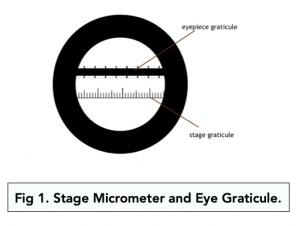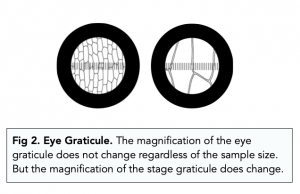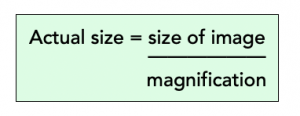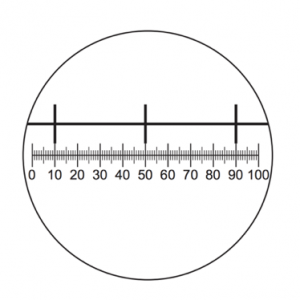Calculating Cell Size (A-level Biology)
How to calculate actual size of cell
- A light microscope can be used to determine the actual cell size. Using a light (optical) microscope, you can easily determine the cell size.
- The stage micrometer is an accurate ruler. The stage micrometer is a very accurate ruler, which shows the true length of the cells.

- After calibration, you can measure the length. Once you have figured out what each unit of measurement corresponds to in the eyepiece graticule, you can place your specimen on the stage. You can then use the eyepiece graticule to measure the length of the cells accurately in micrometers.

- You can also use a simple formula. Another way to calculate the actual size of cells is by using this simple formula:

In the exam, you may be given an image of a cell. Along with the image of the cell, you may be given the size of the image, as well as the magnification at which the image was taken. Using this simple formula, you can easily solve for the actual size of the cell.
Example: The diagram below shows an eyepiece graticule and stage micrometer. The stage micrometer has divisions every 0.1mm.

The eyepiece is used to investigate a cell sample. How many graticule divisions will cover a cell diameter of 20µm?
(Question based on CIE 2010)
Answer
1 division of the stage micrometer is 0.1mm.
You can see from the diagram that there are 40 divisions of the eyepiece graticule in 1 division of the stage micrometer.
Therefore the size of 1 division of the eyepiece graticule is 0.1mm / 40 = 0.0025mm. Converting this to µm (1mm = 1000µm), means one division is 2.5µm
The cell diameter is 20µm, so it covers 8 divisions (10µm / 2.5µm).
Cell size is a measure of the volume or surface area of a cell, and is important to calculate in order to understand the properties and functions of the cell. This information can be used to study cell growth and division, as well as the transport of materials in and out of the cell.
The most common methods for calculating cell size include measuring the diameter or length of the cell using a microscope, and calculating the volume using mathematical formulas based on the shape of the cell. Some methods also involve using dyes or labels to make the cell more visible for measurement.
The shape of a cell can greatly affect the calculations of its size, as cells can be round, oval, flat, or irregular in shape. For this reason, it is important to consider the specific shape of the cell when using mathematical formulas to calculate its volume or surface area.
Yes, cell size can be used as a tool to identify different types of cells. For example, larger cells may indicate a mature, differentiated cell, while smaller cells may indicate a younger, more actively dividing cell.
During cell division, the cell size may remain constant or increase slightly. However, during cell growth, the size of the cell will increase as the cell takes in more materials and grows in volume.
Changes in cell size can affect the overall function of the cell, as larger cells may have a harder time exchanging materials with their environment, while smaller cells may be unable to store enough energy or materials to sustain their functions. An optimal cell size is important for the proper functioning of the cell and the organism as a whole.






Still got a question? Leave a comment
Leave a comment